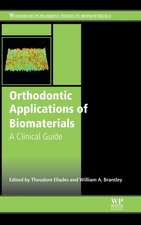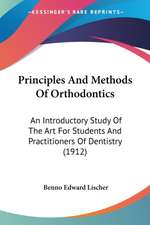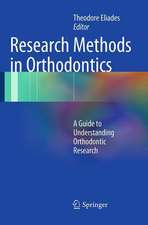Plastics in Dentistry and Estrogenicity: A Guide to Safe Practice
Editat de Theodore Eliades, George Eliadesen Limba Engleză Paperback – 23 aug 2016
| Toate formatele și edițiile | Preț | Express |
|---|---|---|
| Paperback (1) | 834.03 lei 6-8 săpt. | |
| Springer Berlin, Heidelberg – 23 aug 2016 | 834.03 lei 6-8 săpt. | |
| Hardback (1) | 716.45 lei 6-8 săpt. | |
| Springer Berlin, Heidelberg – 10 dec 2013 | 716.45 lei 6-8 săpt. |
Preț: 834.03 lei
Preț vechi: 877.93 lei
-5% Nou
Puncte Express: 1251
Preț estimativ în valută:
159.67€ • 166.60$ • 133.84£
159.67€ • 166.60$ • 133.84£
Carte tipărită la comandă
Livrare economică 12-26 martie
Preluare comenzi: 021 569.72.76
Specificații
ISBN-13: 9783662506127
ISBN-10: 3662506122
Pagini: 152
Ilustrații: VII, 142 p. 34 illus., 7 illus. in color.
Dimensiuni: 155 x 235 x 8 mm
Greutate: 0.22 kg
Ediția:Softcover reprint of the original 1st ed. 2014
Editura: Springer Berlin, Heidelberg
Colecția Springer
Locul publicării:Berlin, Heidelberg, Germany
ISBN-10: 3662506122
Pagini: 152
Ilustrații: VII, 142 p. 34 illus., 7 illus. in color.
Dimensiuni: 155 x 235 x 8 mm
Greutate: 0.22 kg
Ediția:Softcover reprint of the original 1st ed. 2014
Editura: Springer Berlin, Heidelberg
Colecția Springer
Locul publicării:Berlin, Heidelberg, Germany
Cuprins
Endocrine Disruptors -Xenoestrogens: An Overview.- Analytical methods for the determination of BPA in liquid samples.-In vitro assay systems for the assessment of estrogenicity. - BPA effects in vivo: Evidence from animal studies. - BPA and monomer systems in resins. - BPA and dental materials. - BPA and orthodontic polymers.
Notă biografică
Theodore Eliades graduated from the School of Dentistry, University of Athens, Greece, completed the Orthodontic postgraduate program of the Ohio State University, and earned a Master’s from Ohio State, a doctorate from the University of Athens, School of Medicine, and a PhD from the University of Manchester. His research has generated 90 papers and 15 book chapters, which elucidated the in vivo ageing pattern of orthodontic materials and resultant clinical implications, receiving 800 citations. He has co-edited books on ageing of biomaterials (Quintessence), bonding to dental tissues (Springer), orthodontic materials (Thieme), orthodontic practice risk management (Quintessence), and self-ligating brackets (Wiley-Blackwell), some translated into 3 languages. A Fellow of the Institute of Materials, Minerals and Mining, and member of the Royal Society of Chemistry and the Institute of Physics, Dr. Eliades is affiliated with Universities in the US (Texas-Houston and Marquette) and EU (Manchester and Bonn), is an Associate Editor of the European Journal of Orthodontics, and the American Journal of Orthodontics and Dentofacial Orthopedics, Editorial Board member in 5 and reviewer in 22 periodicals.
Gottfried Schmalz: Since 1986 President of various national and international organizations, (CED-IADR, Pan-European Federation, Pulp Biology and Regeneration Group of IADR). German Representative in the Advisory Committee of the EU for Dental Education, Honorary member of several scientific organizations, 2007 Distinguished Scientist Award of IADR. Member of the German Academy of Sciences (Leopoldina). Editor-in-Chief of our journal Clinical Oral Investigations.
Gottfried Schmalz: Since 1986 President of various national and international organizations, (CED-IADR, Pan-European Federation, Pulp Biology and Regeneration Group of IADR). German Representative in the Advisory Committee of the EU for Dental Education, Honorary member of several scientific organizations, 2007 Distinguished Scientist Award of IADR. Member of the German Academy of Sciences (Leopoldina). Editor-in-Chief of our journal Clinical Oral Investigations.
Textul de pe ultima copertă
The polycarbonate products, adhesives, and composite resins used in dentistry may have the potential to release bisphenol-A (BPA). BPA is known to exert effects at very low doses and presents a risk to reproductive, neurological, behavioural, and metabolic development, however, the actual effects induced by dental materials have not been sufficiently covered and critically analyzed. Nevertheless, many practicing dentists will be confused by the occasionally contradictory and often misinterpreted evidence in the literature.
This book therefore represents a timely and comprehensive review of our current knowledge of BPA release from dental polymers and the potential presence of endocrinological consequences. After a review of the history and evolution of the issue within the broader biomedical context, the estrogenicity of BPA is explained. The basic chemistry of the polymers used in dentistry is then presented in a simplified and clinically relevant manner. Key chapters in the book carefully evaluate the release of BPA from dental polymets and the estrogenicity of these materials. Currently available evidence on the potential estrogenic action of dental composites, sealants, and adhesives is presented, and the exaggerated conclusions of various methodological protocols are assessed. The entire dental community will find this book to be an invaluable aid to safe practice.
This book therefore represents a timely and comprehensive review of our current knowledge of BPA release from dental polymers and the potential presence of endocrinological consequences. After a review of the history and evolution of the issue within the broader biomedical context, the estrogenicity of BPA is explained. The basic chemistry of the polymers used in dentistry is then presented in a simplified and clinically relevant manner. Key chapters in the book carefully evaluate the release of BPA from dental polymets and the estrogenicity of these materials. Currently available evidence on the potential estrogenic action of dental composites, sealants, and adhesives is presented, and the exaggerated conclusions of various methodological protocols are assessed. The entire dental community will find this book to be an invaluable aid to safe practice.
Caracteristici
A comprehensive review of current knowledge of BPA release from dental polymers and the potential endocrinological consequences Presents the basic chemistry of the polymers used in dentistry in a readily understandable manner Discusses available evidence on the estrogenic action of dental composities, sealants, and adhesives, and explains the source of misconceptions of some studies, while it guides to effectively minimize adverse effects An excellent guide to safe practice













